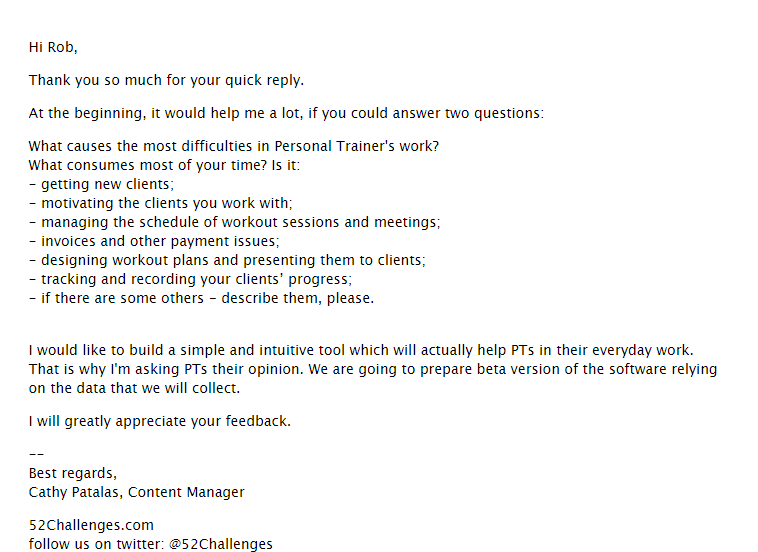Wait, isn’t it that you first send a cold email to set up an interview on the phone..? Well, most probably yes, especially when you have a complete service or product that you want to sell. We didn’t have that then.
What we had was an idea and some research based on articles, comments, questions and answers – written, given, asked and offered, respectively, by fitness pros (and probably a whole bunch of alleged fitness pros) from various places on the web.
That was a good way to start: the research. I took Amy Hoy’s word for that at first (see the video at unicornfree.com to get the idea and purpose of ‘customer safari’), but then I checked for myself and proved to myself that it really works.
But that wasn’t enough. What we needed was the voice of our prospects – first-hand information about how they really work, what they struggle with on a daily basis, what problems they have and how we could actually solve them. We wanted to create a genuinely useful online tool for PTs.
If you’re looking for a way to build your SaaS business faster, hop on board! I’ll take you through how email interviews helped us develop our SaaS company and, who knows, maybe you’ll find that this method is useful for you, too.
Let’s start.
Why choose emails over a phone call? (aka, why we didn’t call)
When carrying out customer interviews, you may either do it on a call or via email. While hoping on a phone and actually chatting to your customers undoubtedly has many benefits, we decided to collect their opinions via email.
Yes, we could try to arrange phone interviews. Nonetheless, we decided that email will be a more efficient channel in this particular case. Why?
Well firstly, we wanted to interview a specific group of people who usually are in the field with their clients all morning, then have a break in the middle of the day (when the clients are at work), and then go back to training sessions for the whole afternoon and evening.
Moreover, they do not sit at their desks, so they cannot talk on the phone while at work, even if this is a work-related matter. Secondly, we are in Europe, and they are in the US, so their midday is at the best possible scenario, our late evening. That’s why setting up a time suitable for both of us to talk on the phone is usually problematic.
So we decided that email will be a more comfortable option for both sides.
If that’s the case with your SaaS as well, see how to conduct interviews through emails.
What can you ask them? (aka, how did I know what to ask?)
As I mentioned before, first I did some research on the net. I went through dozens of fora and portals for fitness professionals. That’s what you should start with, too.
I observed them talk to one another about their professional problems and the solutions they came up with. In the meantime, I learned the language they use to talk about their work.
You may even note down the most often used words and phrases, and then put them in your email copy. This way your prospects will have the idea that you somehow know and understand their business-related issues. Which, in turn, will build more trust and provide you more in-depth feedback.
I identified the most often reoccurring topics and keywords, so when I was writing the copy of my first interview email, I had an idea of what I could ask them about more specifically.

Keep in mind that this was my second email, in reply to their consent to help me from my first touch cold email. So first, I set up a connection and had them declare their will to help me. Then, I sent the questions. (We tested sending the questions as the first touch email, but it didn’t work at all.)
How do you compose the questions? (aka, how did I do it?)
Stick to these three rules:
- keep the questions simple
- ask open-ended questions
- ask about the prospects’ reality, not your solution
I wanted the email to be very easy to respond to. So I came up with two simple questions. I made the questions open, but at the same time I gave a number of possibilities to choose from, as triggers.
Think about it this way: if I asked you just an open-ended question like ‘What causes the most difficulties in your work?’ Would you be able to answer it right away without hesitation or a few minutes to think about it?
I know I wouldn’t. If you would, well, you’ve just realized an overwhelmingly disturbing issue to be taken care of… so go and do something about it. Now.
By giving the trainers some alternatives, I made them comment on the specific areas I was interested in – in order to validate (or invalidate) some hypotheses I had made on the basis on my initial web research.
Also, I didn’t ask questions such as ‘Would you be willing to pay for an app that…’. Instead, I wanted to know what causes them the most problems in their day-to-day work and what do they do to try to solve them.
What were the effects?
Surprising in many ways. First of all, I got many more replies than I thought I would. Second, the majority of the responses were quite exhaustive and really thorough.
The trainers didn’t just point to the areas I listed, but usually elaborated on those that were the most problematic for them. Sometimes they commented all of the triggers, for instance “I don’t have problems with motivating my clients, I usually do this and that to motivate them…” and so on.
The most important effect of the first interview email was that we managed to identify two pains the most often resonating within the answers of the personal trainers we interviewed. One of them was tracking and recording their clients’ progress, and we decided we would be solving this one with our SaaS.
What are the advantages of an email interview over a call?
First of all, I’m not saying ‘don’t call your prospects’. Do call them, if you feel it’s going to be more convenient for both of you and more effective considering the purpose of the interview. For a great insight into the art of interviewing customers, see the article by Garret Moon featured by Ash Maurya.
I’m sure that in numerous cases calls may have advantages over emails. Nonetheless, I’m going to share with you what benefits the email interviews brought us I think calls wouldn’t (at least not to such a great extent).
As I mentioned, in our particular case it was more convenient a solution. And I believe that because it was convenient for our prospects, it was so effective. Moreover, it brought us pages of written feedback which I saw as first-class research materials.
If we called the trainers, we would probably have some notes, but it wouldn’t be the very words of our prospects (priceless when writing a copy for a landing page, or creating content marketing). And it definitely wouldn’t be as in-depth as it was when we asked them to write the answers themselves.
Thanks to the emailed responses, I could analyze all the answers over a couple of months, compare them and prepare some clear statistics which helped us make following decisions. But that’s the advantage I can see now when I look back.
What’s in it for you?
I’m not going to say: ‘do your interviews using email’. That is definitely not a conventional solution and I’m sure it won’t work for everyone. I think it’s important to ask yourself a few crucial questions before you start asking questions to your prospects, whichever channel of communication you decide to use:
- a. What stage you are currently on with your app or service? Is it ready to sell or does it still require significant improvements?
- b. What is the aim of the interview? Or in other words, why do you even bother your prospects: do you want them to help you, to you want to establish a connection with them, do you want them to buy from you after the call? – that’s the point they will be the most interested in, so it’s good to make them feel that in your message.
- c. How much do you know about your prospects? Do you know how they work, what they really struggle with? Do you know how to talk to them? Will you be able to understand their language when they decide to tell you about their pains?
As soon as you get the answers to those questions, it will be easier to choose the right way and time to contact the people whose lives you want to make better.
In the following articles, I’m going to continue to show you what a valuable tool email interviews might be when you’re building a SaaS.
We didn’t end up on a single email. To follow the story, see now:
How Email Interviews Can Help You Build SaaS – Part 2>>
READ ALSO

What Can You Use Cold Emails for in a SaaS Company, besides Outbound Lead Generation?
What’s the first thing that comes to our mind when we think of cold emails in a start-up? Prospecting. Lead generation. Finding new customers potentially interested in our product or service. Fair enough. That’s probably the core application of B2B cold emails right now. But we can do more than that. So, what else can you use cold emails for in your SaaS company?

What’s The First Step to Outbound Prospecting?
Good email copy is important. In 2015, I wrote over 40 posts on various aspects of good cold email copy. But even with the best copy but no people to send it to -- we're stuck. So except for good copy, we need a list of contacts for our outbound prospecting. Outbound prospecting isn't easy. Building a prospect list is hard. It requires lots of time and effort. And with respect to your time and effort, there's one thing you need to do before you roll up your sleeves and start collecting contacts. Actually, it's a question you need to answer to yourself. Here's the question and how to find the answer.

Get More From Your SaaS Website: How to Convert Inbound Leads Into Sales vol 3.
When I look at our Google Analytics data at Woodpecker, I can see that the vast majority of our website visitors that become leads come from organic or paid search. And I believe that it's similar in the case of your SaaS too. The internet users run a query in Google and your website comes up among other results. That's why I believe your website can be one of the surest lead generation tools at your disposal. Let's learn how to do it.

